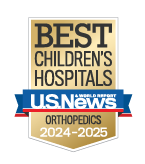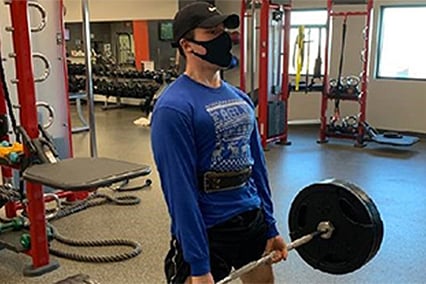Osteochondritis Dissecans (OCD)

Osteochondritis dissecans, or OCD, is an articular cartilage defect that develops most often in adolescents.
Articular cartilage is the coating over the bone and joints. It provides a frictionless, slippery surface, allowing bones to glide over each other and flex freely, like when a car drives over a smoothly surfaced road.
But with OCD, the bone that supports the cartilage inside a joint is damaged, creating a “pothole” that prevents the joint from functioning smoothly, causing joint pain. The joints usually affected are the knee, ankle and elbow, but it can occur in other joints.
What causes OCD?
No one knows exactly what causes OCD. Some think it may be the result of trauma to the joint, while others suspect it may be a genetic defect. The resulting damage is believed to be caused by an interruption in blood flow to a portion of bone.
OCD is most common in adolescents, with the knee being the joint most affected.
Symptoms of OCD are pain, swelling and joint weakness, which are often irritated by sports or physical activity. In more advanced cases, the patient may notice that the joint catches, locks or pops.
Diagnosis and treatment for OCD
A pediatric orthopedic surgeon is best qualified to evaluate and treat OCD. The Children's Mercy pediatric orthopedic surgeons are highly experienced in caring for patients with this condition. They have seen more than 500 patients in the past five years with OCD lesions. They also have cared for a number of patients with acute or traumatic cartilage or bone and cartilage (osteochondral) injuries.
Diagnosis is usually based on the patient’s symptoms, as well as additional testing. These tests may include X-rays, magnetic resonance imaging (MRI) or computed tomography (CT).
In patients who are still growing, the affected bone and cartilage may be able to heal on its own. In grown patients and young adults, OCD can be more serious. There is a greater chance that the OCD lesions will separate from the surrounding bone and cartilage, and can even detach and float around inside the joint. In these cases, surgery is often necessary.
The Children’s Mercy orthopedic surgeons offer different surgical options, depending on the patient’s defect. One option to save the patient’s own cartilage is for the surgeon to drill into the OCD lesion, creating pathways for new blood vessels to feed the affected area, and helping the surrounding bone to heal.
The surgeon also may recommend holding the lesion in place with internal pins and screws. Or, the damaged area of bone may need to be salvaged or replaced with a new piece of bone and cartilage, called an allograft. This can help healthy bone and cartilage re-grow in the damaged area.
MACI®
A new surgical option being performed in certain patients by the Children’s Mercy Sports Medicine Center pediatric orthopedic surgeons is called articular chondrocyte implantation, or MACI®.
MACI uses the patient’s own cells to create a durable repair for damaged knee cartilage. It’s been used successfully for several years in adults, but it requires special approval for patients under 18, and is only performed at a handful of pediatric hospitals in the nation, most of them participants in the Research in OsteoChondritis of the Knee (ROCK) collaborative.
MACI involves two arthroscopies. The first is performed to collect two to three patches of healthy cartilage, each about the size of a Tic Tac®. After removing the patient’s cells, they are sent to a lab in Cambridge, Mass., where they are embedded onto a special mesh-like material and treated to make them expand and multiply.
A few weeks later during a second arthroscopy procedure, the surgeon matches the shape of the cartilage repair material to the defect. After being implanted back into the patient’s defect, the cartilage cells begin regenerating, forming a tissue repair that fills the “pothole,” or the damaged area of the knee cartilage.
Patients typically follow up surgery with several weeks of physical therapy, gradually returning to normal activity.
Researching OCD
The Children’s Mercy pediatric orthopedic surgeons and sports medicine physicians are investigating the theory that OCD is congenital, participating in Genomic Answers for Kids, a flagship initiative of the Children’s Mercy Research Institute and the Genomic Medicine Center.
This research program is building a first-of-its-kind pediatric data repository to facilitate the search for answers and novel treatments. Genomic Answers for Kids collects and stores genomic information and biological samples from children and their biological family members who are searching for diagnoses and are suspected to have rare genetic conditions.
In the case of OCD, tissue samples from more than 500 patients will be sequenced to determine if there is a possible genetic connection that may one day identify the defect and better inform treatment options.
Osteochondritis dissecans: Gabe's story
Gabe Keeton was an active kid until he started having severe knee pain without an explanation. Gabe came to the Sports Medicine Center where he was diagnosed with an articular cartilage defect called osteochondritis dissecans, or OCD. After three knee surgeries, including a newer surgical option called articular chondrocyte implantation, or MACI®, and a dedicated team of experts at Children's Mercy, Gabe is now on the road to recovery.

- Injury Management
- Ankle Injuries
- Athletic Training
- Concussion Treatment
- Gymnast Wrist
- Hockey Injuries
- Human Performance Lab
- Mental Wellness
- Meet the Sports Medicine Team
- Osteochondritis Dissecans (OCD)
- Patella Tendonitis (Jumper’s Knee)
- Patellofemoral Pain Syndrome (Runner’s Knee)
- Sports Medicine Center
- Sports Physical Therapy
- 360° Tour of Village West
